10/9/16: The garden season is pretty much over for us, time to clean out the garden and get the garlic planted. Most of the tomato plants outside have been severely affected by disease, but the ones in the hoop house, while showing some disease, are still growing and ripening tomatoes. That was a huge success of an experiment! Still have tons of peppers on the plants, and no idea what I'm going to do with them; some I will freeze, but there are just so many that I can use. Definitely will grow fewer peppers AND tomato plants next year. I've been hoping to put up a big (16x20) hoop house to replace the greenhouse for seedlings AND for growing more of the tomatoes plus other things. I have a pretty good plan put together for it, but not sure whether it's going to happen.
Dick and Toni are leaving today to go back to Florida for the winter; it sounds like they're planning to try to sell their house and buy something here as their permanent residence. It was quite a summer with them here... lots of family get-togethers and partying!
---------------------------------------------
12/13/15: Mid December and we have no snow on the ground, high temps have been in the 30s to 40s, lows in the 20s to 30s, and we're supposed to be getting about 3 inches of rain over the course of today and tomorrow! The mild weather is enjoyable, although somewhat disturbing; I'm wondering how this will affect the fruit trees and such, as well as things like garlic and daffodils.

The beta seed swap here at ATP has been wrapped up, should have my seeds before Christmas! I was disappointed that the Piggy Swap was cancelled this year, due to Ella's health issues, but this one was fun and I'm glad I joined it.
6/13/15: Watching a TV show (recorded from a few days ago) called "The Seventies." Whew, lots of memories surfacing... not only about the television shows of the time, but that time period was my intro to grown-up-ism. Married in 1971 to my college sweetheart (after he served in the Army for 2 years), only to divorce 15 years later ![]() Still makes me sad, despite having a great husband now; just a really deep sense of failure attached to it.
Still makes me sad, despite having a great husband now; just a really deep sense of failure attached to it.
6/11/15: I love my horoscope for today, from our local newspaper: "Your joy is in the creative process. If it doesn't turn out perfectly, that in no way robs you of the excitement that comes with making the effort. You may not have all the skills you need yet, but with each try, you're getting them."
6/3/15: Vet appt for the collies for their routine heartworm test and heartworm meds; found out they are both positive for Lyme disease! Now have antibiotics for the next 21 days... which hopefully will knock it out of them. Seriously can't remember why we opted to not vaccinate them for Lyme last year (??)
5/31/15: Jim Klein's dad, Bob, died today, from pancreatic cancer. We hadn't seem him in quite a long time, but I have a fond memory of him asking me what my favorite medical term was (he was an opthalmologist, I was a medical transcriptionist), and I answered "homonymous hemianopsia." LOL, who else could I have said that to and have them explain to me exactly what it meant! RIP, Bob.
4/10/15: Back from Vegas -- had 2 kind of iffy plane landings, coming into Vegas it was really windy and the landing was pretty shaky; then on the way back there were huge storms all across the country and our plane, which was heading for Detroit, was actually routed to just about over Green Bay, where our car was, and then back down to Detroit. Pretty darn bumpy landing that time, too... the girls sitting a couple rows back of us had their oxygen masks deploy! In between landings, we discovered that Vegas is no longer the land of cheap buffets, or anything else cheap, for that matter... we aren't all that big into gambling, but were able to get a good return on our money by playing the video poker machines in the bars while drinking free drinks... and went to see the play "Jersey Boys" at Paris, which was excellent and the highlight of the trip. Also discovered that we can't seem to walk as far as we once could... there was a day when we literally walked from one end of the Strip to the other, this time walking from one end of a hotel/casino was a challenge! We learned how to buy tickets for the bus that runs up and down the strip, using the machines that are at every bus stop -- not exactly intuitive, once we figured it out we were then helping other people that were having trouble with it! Took the bus down to Mandalay Bay to go see the "Shark Reef" aquarium, which was really fun and worth waiting in line for about 45 minutes.
4/5/15: Easter Sunday, and leaving for a Las Vegas getaway for a few days... didn't realize that it was Easter when we made the reservations, LOL (but not like that made any actual difference to us).
3/24/15: Celebrated our 25th anniversary today -- it's a wonderful thing to be married to a great guy and I try to remind myself of that every day!
1/23/15: My seeds from the Piggy Swap on Ella's Garden (at Cubits.org) have arrived !! OMG, I really went overboard with my seed requests!
[ Permalink ]
How to make and use tomato powder: http://www.freshbitesdaily.com...
Dry the tomatoes in a dehydrator.
Put the dried tomatoes into a freezer bag and store in the freezer for about a week, which will kill off any bug eggs that may be present.
Remove the tomatoes from the freezer and immediately process in a blender; blending while frozen will yield the finest powder.
Transfer the powder to a glass container with a tight-fitting lid and store in a cool place, away from direct sunlight.
Using tomato powder:
Add to soup.
In enchilada sauce.
In salad dressings.
Add to hamburger when making patties or otherwise cooking.
In vegetable dips.
Add to pasta sauce for more intense flavor.
Sprinkle into scrambled eggs before cooking.
*A heaping tablespoon of this powder gives as much tomato flavor to a sauce as a pint of canned tomatoes.
Tomato disease identification
http://vegetablemdonline.ppath...
Tips for growing heirloom tomatoes, from Johnny's Selected Seeds; lots of great info, including grafting and pruning.
http://www.johnnyseeds.com/t-1...
Blossom-end rot: try using wood ashes at the time of planting.
--------------------
Tomatoes I'm growing in 2021:
Sunrise Sauce 2
Warrior 2
4th of July 1
Juliet 1
Riesentraube 1
Mexico Midget 1
Viva Italia 4
Salvaterra's Select 1
Big Yummy 1
Jamestown 2
Wayahead 2
Baby Boomer cherry tomato (pot)
Big Beef 1
Maglia Rosa
Tomatoes I'm growing in 2020:
4th of July indet (1)
Cedro (plum) indet (1)
Comstock (roma) indet (1)
Golden Girl indet (1 cage, 2 plants)
Juliet indet (1)
Brandymaster indet (2)
Riesentraube indet (1)
Big Yummy det (2)
Incas (san marz) det (1)
Jamestown det (1) (GH) (heat tolerant)
Wayahead det (1) (GH)
Mariana (roma) det (1)
Park's Legacy det (1) (GH)
Picus (paste) det (1) (GH) (heat tolerant)
Sunrise Sauce det (1)
Viva (plum) semi det (4)
Warrior det (1)
Wisconsin 55 semi det (2)
Varieties I'm growing in 2019 (all inside the HH and GH)
2 Big Yummy
2 Country Taste
1 Riesentraube
1 Old-Fashioned Goliath
4 Viva Italia
1 Juliet
1 4th of July
1 Djena Lee's Golden Girl
1 Supremo
1 Plum Regal
2 Tumbling Tom
1 Chef's Choice Green
Varieties I'm growing in 2018 (all inside the HH and GH)
2 Country Taste
1 Golden Girl
1 Juliet (grow outdoors)
1 Riesentraube (outdoors)
1 4th of July (outdoors)
1 Indigo Rose (2 plants grown as 1)
1 Bloody Butcher (2 plants grown as 1)
1 Cherokee Purple
1 La Vie en Rose
1 Red October (outdoors?)
1 Fred's Tie Dye
4 Viva Italia
2 Big Yummy
Varieties I'm growing in 2017 (all are growing in the hoop house and larger greenhouse):
(2) Country Taste
(1) Fourth of July
(1) Juliet
(1) Bloody Butcher (actually 2 plants grown in 1 cage)
(1) Paul Robeson
(1) Djena Lee's Golden Girl
(1) Aunt Ruby's German Green
(1) Indigo Rose (actually 2 plants grown in 1 cage)
(1) Brandywine (Cowlick's strain)
(3) Viva Italia
(1) Health Kick
(2) Bush Goliath
Varieties I'm growing in 2016:
(1) Aunt Ruby's German Green (really liked this one last year!)
(1) Djena Lee's Golden Girl
(2) Country Taste
(1) Mexico Midget
(1) San Marzano
(2) San Marzano Redorta
(1) Indigo Rose (this didn't do that well in 2015 but it was so beautiful I want to give it another try)
(1) 4th of July
(1) Juliet
(1) Pruden's Purple
(4) Viva Italia (will plant inside the hoophouse)
(2) Beaverlodge Slicer (inside the hoophouse)
Varieties I'm growing in 2015:
Country Taste
San Marzano
San Marzano Redorta
Mexico Midget
Aunt Ruby's German Green
Riesentraube
Indigo Rose
Black Cherry
Black Prince
Azoychka
The Dutchman
Bloody Butcher
Viva Italia (determinate)
Bison (determinate)
(also starting plants of 4th of July and Juliet to give away)
Note: I'll be growing the two determinate varieties inside the unheated hoophouse; the others will be in the open garden.
4/21/15: So far our orchard consists of 6 grape vines, 2 Montmorency cherry trees, 3 small hazelnut bushes, and 5 Northland blueberry plants.
4/19/17: Adding strawberries this year; planning to grow them inside the new greenhouse.
5/1/17: Also decided to plant some raspberries this year.
Raspberries:
We tried growing raspberries years ago, without success, but had planted them near the edge of the woods with essentially no preparation, etc. This time around we prepared an area in the northeast corner of the yard by stripping off the sod, removing roots and rocks, loosening the soil with the tiller, and amending with 4 buckets of compost, a large bale of peat, and some triple-10 fertilizer, which was again tilled in. John Valiquette brought us 20 "starts" from his patch; he doesn't know what the variety is, but their family has been growing them for many years. I temporarily potted the starts until the new area was ready to plant.
Strawberries:
Ordered 25 Honeoye strawberry plants from Jung Seeds, which arrived on 4/29/17. Potted them up to get them started growing until I can get them planted in the new greenhouse.
5/20/17: So far 7 of the plants, despite looking great at first, have withered away and died. I'm going to try spraying everything with a fungicide to hopefully prevent more losses.
The Learning Library has a number of articles about growing strawberries. One called "The Care and Harvest of Strawberries" states: 'You must not let the new plants set berries in their first year. They will try to fruit, but you must pick off the blossoms as they appear. This way, instead of fruiting, the mother plants will produce vigorous daughters that will yield well the following year.' It will be hard to make myself do that... but past gardening experience tells me that I should follow this type of recommendation.
Another useful article in the Library is "Strawberries in May" ( https://garden.org/learn/artic... ), which seems particularly applicable to growing in the GH.
Grapes:
11/1/16: The vines were initially planted in 2012 (?); up until this past season they have pretty much died all the way back over the winter. I didn't prune them at all last winter, just let them do their own thing, and thanks to that and/or a milder winter they were very vigorous this year. There were quite a few clusters of grapes -- but unfortunately I waited too long to harvest them and the wasps and flies made a mess of things. Not sure if the grapes cracked and attracted the insects, or if the wasps actually chewed them. I will definitely give them a pruning in the late winter and perhaps will try starting a few more vines from the cuttings. Hope to be able to make some grape jam next summer!
Pruning grape vines: http://garden.org/ediblelandsc...
Pruned the vines 4/7 and 4/8/2017:

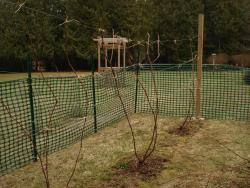
Removed a LOT of plant material!
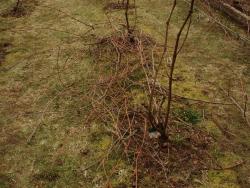
5/12/2022: All of the grape vines were removed a couple of years ago, they were mostly dead after the winter for some reason.
-------------------------
Blueberries:
These were planted in 2013; the winter that followed was the worst that anyone I know can remember having (even for our northern area) in many years, with extended periods of sub-zero temps and a great deal of snow. The snow was probably a lifesaver for a lot of plants, by insulating them to some degree. I did also have them covered with some burlap wraps, which may or may not have helped. However, in the spring of 2014, although I was quite happy that the little plants had survived the winter, when the leaves opened they were a bright gold -- not exactly the color you want to see on a blueberry plant! I tried using an iron spray for the chlorosis, and eventually completely dug up the plants and replanted using sphagnum peat, some compost, and some added sulfur and greensand. At this point I am still waiting to see what the leaves look like this year, as none of the trees or shrubs here have leafed out. Regardless, I am planning to move them into some large pots, using an azalea-type potting mix, in hopes of giving them the acid environment that they need. Of note, these are a half-high type of blueberry, so I believe they will do well in the pots.
11/1/16: The plants were put into large pots in 2015 and wintered over inside the hoop house. Four of them did very well over the 2016 growing season; one was still struggling a bit, but all seemed quite happy in terms of leaf color and so on, and there were a few berries on a couple of the plants. I'll put them in the hoop house again this winter and hopefully next year they will start producing a significant amount of fruit!
4/4/17: All of the plants are looking good inside the HH; time to give them some fertilizer and move the pots outside. Two of the plants still need to be planted in the large pots.
Growing blueberries in containers: http://www.bayeradvanced.com/a...
Recommended mix: 40% untreated peat moss, 40% coir, 20% perlite; add a handful of soil sulfur to each plant
5/12/2022: The blueberries have grown and produced well for us the past couple of years, but last year I noticed some strange growth on a couple of the branches that unfortunately turns out to be something called "witch's broom." My plan is to just keep removing the abnormal growth and hope the plants will continue to do okay for quite some time.
Witches' broom on blueberry plants:
https://extension.umaine.edu/p...
"Infected blueberry plants have broom-like masses of swollen, spongy shoots with shortened internodes and leaves that are smaller than normal. Symptomatic shoots have a reddish yellow color and turn brown and shiny throughout the growing season. As the season progresses, the brooms become dried out and cracked. They will appear dead the following spring.
Balsam fir trees that are infected can experience stunted growth with yellowish-green colored needles. When the spores develop, they appear as small round orange-yellow blisters, occurring mostly on the undersides of the needles.
Because this disease is systemic, i.e. it moves and spreads internally through the plant, burning or cutting out the brooms will not provide control. However, experience in Maine has shown that the symptoms can be managed with judicious pruning, allowing infected plants to remain productive, often for many years, in spite of the disease. It is suggested that broom growth be pruned out as soon as it appears and that the entire branch or cane on which the broom appears, be removed to slow the spread of the fungus through the plant. Once the infection has developed to the extent that heavy broom growth is emerging from the base of the plant and no healthy new canes are emerging, it is best to remove the plant.
Removing any and all balsam fir trees within a quarter-mile of blueberry plants, if possible, can reduce or even eliminate witches' broom. Even if it is not possible to clear balsam to that distance, it is best to keep blueberries and balsam separated to the greatest extent possible.
Although susceptibility to witches' broom appears to vary among different blueberry varieties, and some such as 'Rancocas', may have resistance to the disease, this has yet not been adequately studied.
At this time, there are no effective fungicides for managing witches' broom."
------------------------
Cherries:
My hope is to keep the cherry trees pruned to a manageable level, so that I can easily cover them to protect the fruit from birds, as well as be able to pick them myself. Once again I failed to pre-plan and study up on this subject before planting the trees last year... but they did not put on a great deal of growth that first year, so I don't think anything was lost by giving them a year to acclimate.
11/1/16: I did prune the cherry trees this past spring, particularly taking the top back quite a bit on the westernmost tree. Both seemed to do quite well and even had a few cherries this year.
4/4/17: Both trees appear to have come through the winter well (we had quite a mild winter again); need to do a little pruning of dead twigs.
Pruning cherry trees for the backyard orchard:
http://www.davewilson.com/home...
5/12/2022: Unfortunately one of the trees was broken by a bear that has been visiting recently; last year was the first year that there were a fair number of cherries on the trees. Apparently Montmorency does not need a 2nd tree for pollination, so maybe the remaining tree will continue to do well.
--------------------------
Hazelnuts:
I started out several years ago with 5 very small plants from Musser Forests, planted them in the garden for a couple of years, then planted four of them out, one died in 2014, and we now have only 3 plants. I'd like to get several more to add to the row, and perhaps even more to naturalize around the edges of the woods for the wildlife. The 3 that we have do appear to have come through this past winter okay, but again nothing is even close to leafing out.
11/1/16: The hazelnuts grew well this year; I did receive a couple of new plants from the Arbor Day Foundation, but they are still in a big pot; I'll overwinter them either in the hoop house or in the ground in the outer garden, and plant in the row with the others if they survive the winter.
5/12/2022: All of the hazelnuts were removed a couple of years ago; they never even flowered much less produced hazelnuts.
4/19/2015:
Growing Belgian Endive (Witloof) is quite an interesting process and results in harvesting nice heads (called 'chicons') of salad greens throughout the winter.
Basically this involves:
1. Growing Cichorium intybus seeds. "For optimal root production, Belgian endives prefer direct seeding and culture similar to carrots. They like well-drained, loose soil to promote sufficient development of the roots. Remember, for the first phase of growing endive, the roots are your crop." (From High Mowing Seeds) Plants should be thinned to approx. 4" apart.
2. Digging up the roots in the late fall -- ideally they should be 1-2" across at the shoulder, and about 7" long. Care should be taken to not nick or damage the roots when digging.
3. Curing for several days, then trimming off the leaves and storing the roots at a temperature close to freezing, around 30-34F, for at least a week.
4. 'Forcing,' by replanting the roots in a container filled with a moist soilless mix, which ideally should be placed in a cool area and providing bottom heat, in the dark, keeping the planting mix moist.
5. The chicons should be ready for harvest in about 3 weeks; the heads should be firm and about 5" long. They can be snapped off the root, and need to be protected from light after harvest to prevent greening; care should be taken to keep them clean while growing and harvesting, as washing with water can result in browning.
Note: Some sites say Cichorium intybus is used for witloof production; others say C. endivia. ???
I have seeds for C. intybus... so, we'll see what happens!
Full article in the Grower's Library at Johnny's Selected Seeds:
http://www.johnnyseeds.com/ass...
Another good article -- with lots of photos -- from Kitchen Gardeners International:
http://kgi.org/growing-belgian...
Article from High Mowing Seeds (which sells C. endivia for growing Belgian endive):
http://www.highmowingseeds.com...
_______________________
Garlic – Planting, Harvesting, and Storing
Plant in the fall. Separate the cloves at the time of planting; separating them ahead of time can cause the root nodules to dry out and delay or prevent root formation. Don't remove the "skin" from the cloves.
Plant in an area that drains well. The cloves should be planted 4-6 inches apart and in holes about 3 inches deep; be sure to plant with the root end down.
Several inches of mulch over the top of the garlic bed is beneficial for winter protection, as is a good layer of snow cover. The mulch can be gently raked off in the spring, when the garlic is starting to sprout.
Garlic should be harvested when there are still several green leaves on the stalk; if the tops are allowed to die back completely, there will be no "wrapper" to hold the bulbs together. Each green leaf represents one layer of the papery bulb wrapper. Harvest in my area will probably be in mid to late July. If possible, dig the garlic when the weather is dry.
After digging the garlic, do not cut the tops off immediately; either spread the garlic out to dry in a well-ventilated area where it will be out of the sun and rain (mine goes on big screens on top of sawhorses in the garage), or tie it in loose bunches and hang up in a shed or garage. Allow it to dry for at least a couple of weeks, then cut the tops and roots off and store in paper bags at cool room temperature.
Types of garlic:
Hardneck garlic sends up a stiff "scape" during the growing season, which will produce small garlic bulbils at the top. Softneck garlic does not produce a scape. 'Music' is a hardneck type that produces very tiny bulbils; 'Al's garlic' produces larger bulbils, which can be planted and will develop into a bulb after a couple of years. The scapes can be removed from the plants when young and cooked. Wait until the center stalk completely forms and grows above the rest of the plant. As it grows up it will begin to curl or spiral upward. At that point, cut the stalk as far down as you can without cutting any leaves off. Removing the scapes may also result in larger bulbs of garlic. 'K's Backyard' garlic is a softneck type and does not produce a scape.
____________________________
Information on the web:
From the website "We Grow Garlic in Wisconsin" http://www.wegrowgarlic.com/12...
"A few years ago we also started pre-soaking our garlic as recommended by Bob Anderson of Gourmet Garlic Gardens as an added precaution against pests and diseases. We soak all of our seed garlic before planting whether it's our own seed stock or newly acquired planting stock. Basically what you do is soak the cloves overnight in a solution of one tablespoon of liquid seaweed, and either one heaping tablespoon of baking soda, or one tablespoon of vinegar per gallon of water. (we start with warm water for the soak but that's our own variation) Then follow up with a three or four minute soak in either 140 proof vodka or rubbing alcohol just before planting. The skins will fall off the cloves during this soaking process, that's okay. Note: You really don't want to do this soaking process inside the house. It stinks to high heaven!!! Also be sure to process each variety separately or you're not going to know what they are when you're all done."
However, they also go on to say:
"Note: We are starting to rethink the automatic soaking of all the garlic versus using it just if we think a precaution is necessary as we have been experimenting and have observed that cloves that are handled as gently as possible during planting with clove skins left intact (they fall off during soaking) and planted without soaking have been producing larger bulbs for us than those that were soaked. We are still experimenting and observing to see if that holds true over a number of growing seasons to discount the effects of various weather conditions."
This site also has a number of recipes using garlic and garlic scapes.
_______________________
Long thread about garlic here on ATP: The thread "Garlic" in Vegetables and Fruit forum
_______________________
Growing garlic; with a good section on common pests and diseases:
https://www.plantvillage.com/e...
This page has a great list of different varieties: http://www.wegrowgarlic.com/74...
Types of garlic -- from Filaree Farms:
Turban garlic:
"Turban garlics are the earliest to harvest, often several weeks before other varieties. Their cloves are succulent and hot. They originate from SE Asia and are fantastic for flavoring cuisine from this region. A great choice for early markets, these bulbs impress with their flattened shape and striking purple blotching. These strains are often the first to sprout in the spring. Turbans are weak-bolting hardnecks; usually producing scapes in the northern states but seldom in warmer climates. A top choice for the Gulf Coast and other warm climates, yet adaptable enough to grow large bulbs at our home farm in far north Washington State. 50-65 cloves in a pound."
Rocambole garlic:
"Rocambole garlics are renowned for their complex and full flavor, often referred to as "true garlic flavor." These strains are the most well-known and hence, widely grown of the hardneck varieties. Beautiful, low growing plants with a deep green/blue tint. Scapes are delicious, growing into several tight curls. The clove skins are very loose on Rocambole cultivars, sometimes not even completely enclosing the clove. This can lead to some discoloration on the cloves which is normal. While the loose clove wrappers make for easy peeling in the kitchen, they also lead to the greatest disadvantage of Rocambole strains- shorter storage life than other varieties. While best suited for northern climates, Rocamboles are grown successfully by those in all but the warmest of climates."
Artichoke garlic:
"Artichoke strains are generally the most productive and easy to grow of all garlic varieties. A softneck variety, they have multiple layers of cloves with as many as twenty large plump cloves in a single bulb. Artichoke strains can be grown successfully in almost any climate. They perhaps contain the greatest diversity in flavor between strains, some are quite spicy and rich while others are the mildest of any strains that we sell. Colors rage from bright white to red and purple streaks."
Asiatic garlic:
"These strains took a long time track down! Asiatics are a unique group with a wide range of characteristics. Large, plump cloves are richly flavored, hot raw, yet creamy and flavorful when cooked. Fine striping sets these strains apart, with colors raging from white and yellow/beige to purple and reds. These strains can be grown in a wide range of climates. In northern climates they generally produce an usually scape with a long bean-pod shaped bulbil capsule, in southern climates they may produce no scape at all. Medium-long storing."
Creole garlic:
"The Creole strains have many excellent qualities; size is not one of them for most northern growers. We sell a minimum 1.5 inch bulbs for our creole strains. When planted in warmer climates, they generally grow larger than this. Some years they do grow larger for us here near the Canadian border. Creoles have excellent flavor, great for raw use in salads and marinades. They also have magnificent bright red clove wrappers and store exceptionally well. "
Porcelain garlic:
"Porcelain strains have become increasingly popular in recent years for good reason. These hardneck strains produce large bulbs with 4-7 large cloves. Great in the kitchen, you may only need to peel one or two cloves for a meal as the cloves can get as large as elephant garlic. Most of these strains have strong heat, both raw and cooked. An excellent choice for cold climates and high elevation locations. Some of the strains have proved to be adaptable to southern climates. Note that Porcelain strains average 40 cloves to the pound and therefore may require extra pounds of seed to produce desired crop."
Purple Stripe garlic:
"Named because of the bright purple streaks and blotches on both bulb wrappers & clove skins, these are the most attractive looking garlics. They are also very flavorful, usually winning "best baked garlic" taste tests conducted by Rodale, Sunset Magazine, Martha Stewart and others. Most strains have 8 to 12 cloves per bulb. Cloves are noticeably tall and crescent shaped. They are medium storing and easy to peel. Can be grown in many different climatic regions. 50-60 cloves in a pound."
Silverskin garlic:
Sillverskin garlics are the type most often found on supermarket shelves due to their very long storage life. They are a very high yielding softneck variety and do well in a wide range of climates, hot southern, wet maritime, and cold northern climates as well. Bulb wrappers are fine and smooth, usually all white. 12 to 20 cloves in a bulb.
Silverskins have long been the most popular garlics for braiding because of their pliable necks and smooth, shiny skin. These are the last garlic harvested and may lodge (fall over) a week or more before harvest due to their weak necks. Approximately 70 cloves in a pound of seed."
-------------------------------
Why grow garlic from bulbils? "There is an advantage to planting garlic bulbils over cloves. Propagating from garlic plant bulbils can revitalize garlic strains, thwart the transmission of soil-borne diseases and is economical as well." http://www.gardeningknowhow.co...
How and why to grow from bulbils: http://greyduckgarlic.com/How_...
They note that bulbils aren't likely to carry soilborne diseases, which could be important. Also, starting with 40 bulbils, by the 4th year you could harvest up to 2500 full-size bulbs; very economical if you have the patience!
http://greyduckgarlic.com/inde... (everything you ever wanted to know about garlic!!)
---------------------------------
4/13/15 - Some thoughts about growing garlic in the far north:
I've had reasonably good success with growing both hardneck and softneck types, although I don't feel the bulbs that I've harvested have been as large as they could be. The first year that I grew garlic I waited much too long to harvest, letting the leaves dry completely down like I do with onions, and had nothing but loose cloves when I dug into the ground -- I've since learned that you need to have several leaves that are still green, as those correspond to the "wrappers" around the bulbs. I initially tried growing the softneck types because I wanted to make "garlic braids" both for myself and to give away; although that project worked out pretty well, it seemed like more work than it was worth, and I didn't like the fact that my bulbs didn't look as nice and clean as the ones that I've seen being sold (I wonder how they do that?). I prefer using the hardneck types, as the cloves are typically considerably larger than with the softnecks; however, I've recently learned that the softnecks will store longer than hardnecks, so that would be a reason to continue growing them. This year I have a Creole variety, Ajo Rojo, planted -- both inside the unheated hoop house and out in the open garden -- which is supposed to store the longest of all. It remains to be seen how successful that type will be here in the north.
The garlic that I planted in the HH last fall -- the Creole and another softneck type -- is coming up very nicely, considerably ahead of the garlic out in the garden (and this past winter wasn't all that bad, nothing like the previous one). If the HH-planted garlic does well I might plant a lot more of it under cover this fall -- I think the more controlled water amounts could be very beneficial, as well as the quicker warming of the soil in the spring. Keeping the garlic on the dry side near harvest tiime would be a good thing, as well as I just recently saw a comment by DrDawg (Ken) about rainy spring weather seeming to reduce the size of the bulbs - and we almost always have rainy spring weather!
Storage: I've been storing my garlic, after allowing it to cure on screen racks in the garage, in paper bags in the (unheated, attached) garage during the winter. However, I'm now wondering if being exposed to the near-freezing to occasionally below freezing temps is actually triggering it to start sprouting sooner than it would if stored in a bit warmer environment. This year I'll try putting it in the closet in the spare bedroom, which is generally kept closed off during the winter and stays right around 60 degrees F.
Planting: Need to select the largest bulbs for replanting; this is another mistake I've made in the past, using some of the smaller bulbs to plant and keeping the nicest ones to use. Last fall I did use nice large bulbs, so I'll see if that makes any difference. Also need to consider cutting all the scapes off the hardneck plants so that they can put that energy into growing the bulbs. The scapes are also edible, so no need to waste them! Another mistake: I was previously using a spacing of about 3-4 inches, this year I learned that 6-8 inches is needed to get large bulbs. If I use 6" spacing, I could probably get about 280 plants inside the HH, which should be plenty! I actually wouldn't need to plant that many, and could then use some of the extra area for some hardy greens. (See note below regarding my harvest on 7/24/15)
5/8/15 - I've noticed that some of the leaves on only the Ajo Rojo garlic have some areas of yellowing; although a bit of internet research has indicated that it could be disease or something like nematodes or maggots, it also could be due to needing more nitrogen, or to late frosts (some types are more susceptible to damage from frost, and since the other varieties are perfectly green I suspect this is the cause). I was planning to give the garlic some fertilizer at any rate, and will keep my eye on the situation to make sure it doesn't seem to be progressing.
6/25/15 - I did fertilize several weeks ago, but now am noticing a lot of yellowing leaves on the Music; will dig a bulb or two to check for rot, onion maggots, etc. Seems much too early for them to be dying back due to maturity, since spring was late this year and I normally wouldn't harvest until at least the end of July. (Note: the garlic that I dug up seemed perfectly okay, with very healthy roots and undamaged bulbs.)
7/24/15 - 2015 Garlic Harvest:
Dug all the garlic on July 24th; while I'm overall happy with the size of the bulbs, I was somewhat expecting them to be a bit larger, after reading that I should (1) select the largest cloves to plant, and (2) space the cloves at least 6" apart. I had previously been using and giving away the very nicest bulbs (with the biggest cloves), and only spacing the cloves at 3-4" when I planted. This year I did plant large cloves at about 6" apart, but am not sure I notice any real significant difference. Unsure whether to try one more year (particularly with the wide spacing), or if I should just conserve the space.
Ajo Rojo (Creole type)
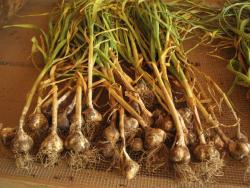
Mixed softneck garlic, Polish Softneck and Western Rose
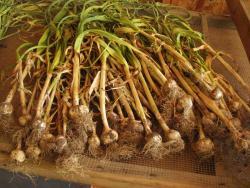
Music (Porcelain-type hardneck garlic)
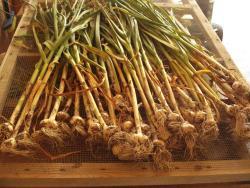
Unidentified hardneck, originally from Al Erickson, via Bob Anderson
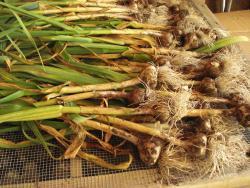
8/20/15: I've finished cleaning up all the bulbs; very pleased with the timing of harvest this year, the "wrappers" were thick enough that I could remove a couple of layers and leave nice-looking bulbs (for the most part, anyway). Al's garlic was by far the best of the ones that I grew this year; the bulbs are larger than they've ever been in the past, so perhaps selecting the largest cloves to plant and spacing the plants further apart did have something to do with that. The softneck garlic cleaned up nicely enough that I'll make a couple of braids with the best bulbs. The Ajo Rojo isn't terribly large, but I'm hopeful that by planting the best bulbs I can eventually have a selection that will do really well here. Have plenty of garlic to use and to plant about 50 of each type; also decided to order a new (to me) softneck variety from Baker Seeds, instead of growing the kind I've been growing. I originally had Polish Softneck and Western Rose, but didn't keep them separate and now have no idea what I actually have. Ordered enough of a variety called K's Backyard to plant 50 of that as well. This is the description from Baker Seeds: "Very Rare. This is a big, pearly-pink Artichoke variety that we found growing in an old Santa Fe garden in 1998. It originally had very small cloves the size of sunflower seeds and it is now our biggest softneck garlic. We have sent it to growers across the country and it seems to grow well in both coastal and cold regions – grower Paul Parma in Southern California said he'd never seen a garlic so huge. It has a rich, classic Italian flavor."
8/22/15: After visiting a farm stand in Marinette, Wisconsin to guy some sweet corn to freeze, I feel a LOT better about my garlic; they had some garlic bulbs for sale, 3 for $1.00, that couldn't have been much more than 1 inch in diameter! I would be totally embarrassed to put those out for sale...
10/13/16: Haven't added any observations in quite a while! Got a great garlic harvest this year; last fall I planted Music, Ajo Rojo, the NoID that I call "Al's," and a new to me softneck variety from Baker Creek called K's Backyard (see the description above in the note from 8/20/15). I planted the cloves about 6" apart (I've normally planted closer together), and we had a very favorable winter for a change, and all of the varieties did well -- particularly the K's Backyard, which produced VERY large bulbs (at least as compared to what I normally get). It was the first variety that I dug up, and I was truly astounded at the size of the bulbs. The 2nd largest were Al's garlic. Of note, I also had much better success with storing my garlic last winter; in the past I had left it out in the garage (unheated, but stays just above freezing in the winter); last winter I put the bags in the spare bedroom (which stays cooler than the rest of the house) once the weather turned cold, and all of the varieties lasted right through to summer without sprouting or shriveling.
7/31/17: Garlic is all harvested and despite the summer not being all that favorable overall (very rainy and cool) the garlic did very well again. K's Backyard continues to produce very large bulbs, and Music and Al's were their usual size. I had selected cloves of Music to plant from bulbs that had 4 cloves (none from the 3-clove bulbs), and actually had a few this year with 5 cloves; those will be used for planting, in hopes of getting more cloves/bulb. The Ajo Rojo was smaller than last year and I've decided not to grow it again.
10/13/17: Planted the garlic: 32 each of Music and Al's, 48 of K's Backyard, and 16 of a new variety, "Moroccan Creole" (from Baker's Creek). This is a smaller total number of plants than usual, but I always have way too much. Purposely planted during the waning moon, which is supposed to be favorable for root crops; can't hurt, and who knows? it just might be of benefit. I'm planning to try to time all (or at least most) of my garden planting next year according to the moon phases.
8/2/2021: Harvested my garlic today - 30 each of Al's (actually a NOID), Music, K's Backyard, and Moroccan Creole; Al's and Music were pretty much the same as they usually are, but K's and Moroccan Creole were exceptionally large compared to previous years. The snow was gone considerably earlier this spring than it usually is, and I did notice that the garlic stalks were larger than usual. Really excellent year for my garlic harvest.